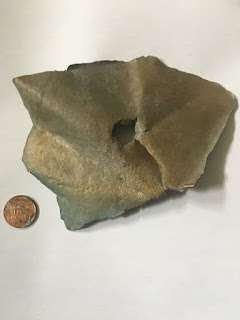Written by the Treasureguide for the exclusive use of the Treasure Beaches Report.
 |
| Metal Beach Find by Jason S. |
Jason S. sent me this message and the photo above.
I stumbled across an old article pasted below while trying to identify a piece of what I believe is bronze sheeting. I found it on the beach in Kitty Hawk, NC as I was picking up trash that washed ashore after a tropical storm ruined my surf fishing. Any feedback about how to tell if it is bronze and what it might have come from would be greatly appreciated.
You might recall that one of the storms this years was up around North Carolina.
I thought it might be Muntz metal and Jason thought that might be right. Muntz metal was patented in 1832, and it is not uncommon to find the patent mark on nice size sheets. I've had several readers send in pictures of that.
See The Treasure Beaches Report Direct From Florida's Treasure Coast.: 9/16/18 Report - After Florence. A Couple Finds. Muntz Metal and Copper Sheathing, for example. You can find other posts showing patent marks on Muntz metal if you search treasurebeachesreport.blogspot.com.
While the use of Muntz metal increased dramatically over the next several years after its invention, I don't know when it went out of fashion for sheathing. It is still used for some marine applications, although newer coatings and other methods have replaced it to some extent
You might be interested in this article - What is Muntz Metal and Where is It Used in the Modern World? (rotaxmetals.net).
Here is one paragraph from that article.
Today, Muntz metal is still used for many maritime applications, despite the emergence of other similar metals like naval brass. Many shipbuilders still prefer to use Muntz metal for its cost-effective nature and incredible durability. Although only a few ships use Muntz metal as the protective layer of ships, the metal is still used in other applications on a ship, including fittings, pipes, and the like.
The RotaxMetals blog provides a lot of good information on other metals as well.
Here is a post on cleaning tarnished metals.
Simple Tips on How to Clean Tarnished Metal Objects (rotaxmetals.net)
---
You might find the University of West Florida web site on the Luna settlement interesting.
Here is the link.
Since its discovery in 2015, the University of West Florida has conducted archaeological investigations at the site of Santa María de Ochuse, Tristán de Luna y Arellano’s 1559-1561 settlement on Pensacola Bay. After nearly four years of fieldwork and lab work, the site has already revealed a substantial and diverse assemblage of artifacts associated with equipment, supplies, and provisions brought both collectively by the army and its companies and subordinate residential and dining units, and by individuals as personal goods. Moreover, the discovery of features such as trash pits and postholes supplement an increasingly detailed understanding of the horizontal distribution of artifacts to provide important clues regarding the layout of the 31- acre settlement and the activities conducted there, supplementing what the documentary record tells us about this site and the people who inhabited it. This paper provides an update of our current understanding of this important mid-sixteenth-century Spanish settlement.
If you use the link above, you'll find a number of other useful links to more information on the Luna wrecks and settlement. Not all of the links were working, but many were.
The Luna settlement was discovered when a home owner excavated land to build a new house and noticed a lot of shards in the earth.
---
 |
| Devotional Medals In the Florida Museum Collections. |